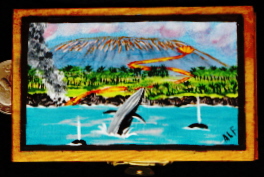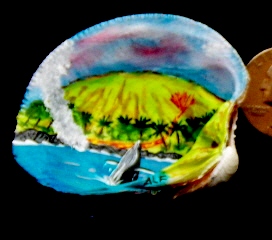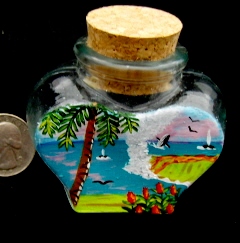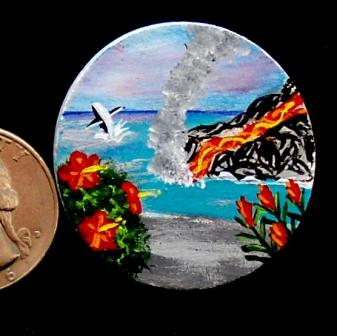Hawai'i Island Volcano, Volcano National Park, Volcano House,
Pele the Volcano Goddess,
Pele the Volcano Goddess,
Hawai'i Island Volcano
Scenic Places, Stories and
Historic Hawai'i Landmarks.
Historic Hawai'i Landmarks.
Kīlauea is the youngest and southeastern most volcano on the Big Island of Hawai`i. Topographically Kīlauea appears as only a bulge on the southeastern flank of Mauna Loa, and so for many years Kīlauea was thought to be a mere satellite of its giant neighbor, not a separate volcano. However, research over the past few decades shows clearly that Kīlauea has its own magma-plumbing system, extending to the surface from more than 60 km deep in the earth.
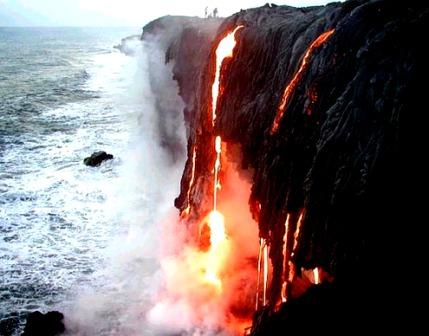
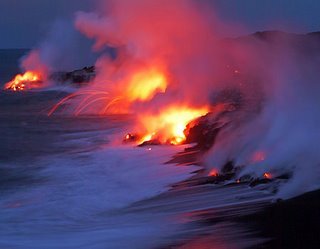
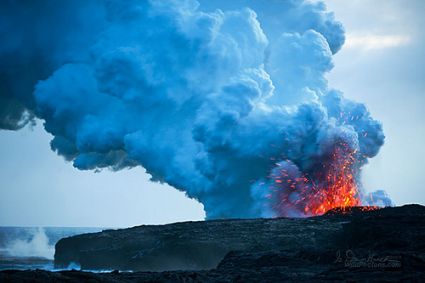
In fact, the summit of Kīlauea lies on a curving line of volcanoes that includes Mauna Kea and Kohala and excludes Mauna Loa. In other words, Kīlauea is to Mauna Kea as Lo`ihi is to Mauna Loa. Hawaiians used the word Kīlauea only for the summit caldera, but earth scientists and, over time, popular usage have extended the name to include the entire volcano.
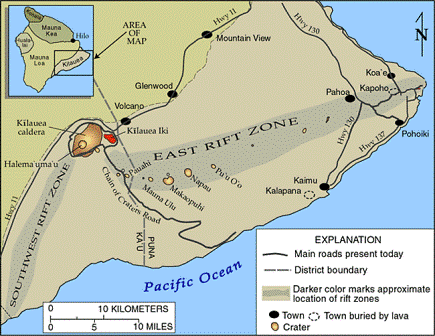
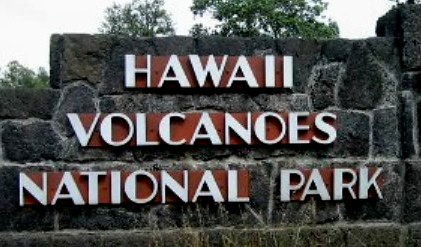
The eruption of Kīlauea Volcano that began in 1983 continues at the cinder-and-spatter cone of Pu`u `Ō `ō. Lava erupting from the cone flows through a tube system down Pulama pali about 11 km to the sea.
Kīlauea is the home of Pele, the Hawaiian volcano goddess. Hawaiian chants and oral traditions tell in veiled form of many eruptions fomented by an angry Pele before the first European, the missionary Rev. William Ellis, saw the summit in 1823. The caldera was the site of nearly continuous activity during the 19th century and the early part of this century. Since 1952 there have been 34 eruptions, and since January 1983 eruptive activity has been continuous along the east rift zone. All told, Kīlauea ranks among the world's most active volcanoes and may even top the list.
established in 1916, is located in the State of Hawai'i on the island of Hawai'i.
~~~~~~~
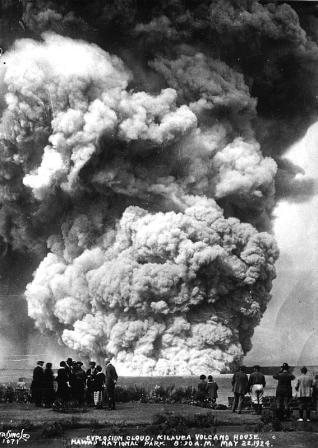
The park displays the results of hundreds of thousands of years of volcanism, migration, and evolution processes that thrust a bare land from the sea and clothed it with complex and unique ecosystems and a distinct Ancient Hawaiian culture. Kilauea one of the world's most active volcanoes, and Mauna Loa, the most massive, offer scientists insights on the birth of the Hawaiian Islands and visitors' views of dramatic volcanic landscapes.
The volcanic activity generated in Hawaiʻi Volcanoes National Park helped create Kalapana (now covered by lava from recent eruptions) and other black sand beaches. Within the park boundaries are the Thurston Lava Tube, a lava tube approximately 540 years old with a short hiking trail running through it,
Above picture taken in May 1924
and the Kilauea Caldera, skirted by the Volcano House Hotel, and the Hawaiian Volcano Observatory which operates the Thomas A. Jaggar Museum.
Hawai'i Island's First Hotel
Volcano House
Volcano House


Volcano House 1866
About 1846 a primitive one-room grass shelter was constructed at the rim of the Kīlauea crater by Benjamin Pitman, Sr., the first hotel to call itself "Volcano House". However, sometimes visitors would show up after the long journey and nobody would be home. A more substantial wood frame structure was built in 1866 with four bedrooms, parlor, and dining room. Mark Twain stayed here, and wrote about his visit in the book "Roughing It"
The hotel circa 1912 – center built in 1891 and the wing on the right is the 1877 structure
In 1876 George W. C. Jones bought out the other partners in the business and hired William H. Lentz to construct a longer-lasting structure. A wood-sided building about 104 feet by 110 feet was built in 1877. It included six guest rooms, two for the manager's family, and a dining room. In 1891, a group led by Honolulu businessman and politician Lorrin A Thurston (grandson of the missionary from the 1820s) acquired the Volcano House and Peter Lee's hotels. The business was so successful that a two-story addition became the main part of the hotel, adding 10-12 additional guest room, an observation tower, and a larger dining hall, using the 1877 structure as a wing.
Hawaiʻi Volcanoes National Park
In Hawaiian mythology Pele (pronounced PAY-lay in English) is the goddess of fire, lightning, dance, volcanoes and violence. She is a daughter of Haumea and Kane Milohai, and her home is believed to be the fire pit, Halema'uma'u crater, at the summit caldera of Kilauea, one of the Earth's most and continuously active volcanoes; but her domain encompasses all volcanic activity on the Big Island of Hawai'i. In the book of night of the howling dogs.
There are several traditional legends associated with Pele in Hawaiian mythology:
"Pele" the Volcano Goddess
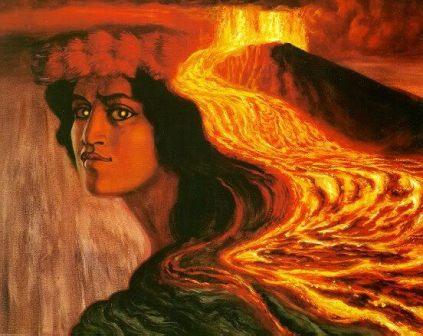
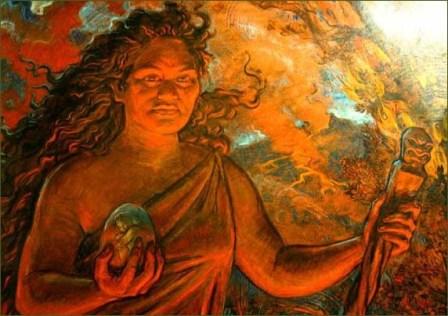
Expulsion version
Pele is born to Kane-hoa-lani and Haumea in Kuaihelani. She sticks so close to Lono-makua, the fire god, as to cause a conflagration (or, as in the Aukelenuiaiku story, makes love to her sister's husband) and her older sister Na maka o Kaha'i, called "a sea goddess," drives her away. She takes passage in the canoe Honua-i-a-kea with her little sister carried in her armpit and accompanied by her brothers Ka-moho-ali"i, Kane-milo-hai, Kane-apua, and others, and arrives at the Hawaiian group by way of the northwestern shoals. There Kane-milo-hai is left on one islet as an outguard and Kane-apua on another, but Pele pities this last younger brother and picks him up again. A group of songs relate the relentless pursuit of the party by the older sister until the two sisters encounter each other in Kahiki-nui on the island of Maui and Pele's body is torn apart and the fragments heaped up to form the hill called Ka-iwi-o-Pele (The bones of Pele) near Kauiki, while her spirit takes flight to the island of Hawaii and finds a permanent home on Hawaii.
Pele is born to Kane-hoa-lani and Haumea in Kuaihelani. She sticks so close to Lono-makua, the fire god, as to cause a conflagration (or, as in the Aukelenuiaiku story, makes love to her sister's husband) and her older sister Na maka o Kaha'i, called "a sea goddess," drives her away. She takes passage in the canoe Honua-i-a-kea with her little sister carried in her armpit and accompanied by her brothers Ka-moho-ali"i, Kane-milo-hai, Kane-apua, and others, and arrives at the Hawaiian group by way of the northwestern shoals. There Kane-milo-hai is left on one islet as an outguard and Kane-apua on another, but Pele pities this last younger brother and picks him up again. A group of songs relate the relentless pursuit of the party by the older sister until the two sisters encounter each other in Kahiki-nui on the island of Maui and Pele's body is torn apart and the fragments heaped up to form the hill called Ka-iwi-o-Pele (The bones of Pele) near Kauiki, while her spirit takes flight to the island of Hawaii and finds a permanent home on Hawaii.
Flood version
Pele is born in Kapakuela, a land to the southwest, "close to the clouds," and her parents are Kane-hoa-lani and Ka-hina-li"i, her brothers Ka-moho-ali"i and Kahuila-o-ka-lani. By her husband Wahieloa (Wahialoa) she has a daughter Laka and a son named Menehune. Pele-kumu-honua entices her husband from her and Pele travels in search of him. With her comes the sea, which pours from her head over the land of Kanaloa (Kahoolawe), never before so inundated, and her brothers chant,
"A sea! a sea!
Forth bursts the sea,
Bursts forth over Kanaloa (Kahoolawe),
The sea rises to the hills. . . ."
"Thrice" (according to the chant) the sea
floods the land, then recedes. These floodings
are called The-sea-of-Ka-hina-li"i.
Ohia, Lehua and Goddess Pele
A Hawaiian Love Story
A Hawaiian Love Story
If you pick a red lehua blossom they say it will rain...
A Hawaiian folklore story...
This story came from a Jack's Tours bus driver, Uncle Loren.
Once there was a handsome man named 'Ohi'a. 'Ohi'a met a beautiful lady named Lehua, they were boyfriend and girlfriend. One day 'Ohi'a passed by Pele the goddess of fire. Pele immediately fell in love with him so she said, "I like you, be my boyfriend," but 'Ohi'a told Pele that he had already had a girlfriend named Lehua. Pele was mad that he wasn't her boyfriend, so she set a spell on him and turned him into an ugly tree.
When Lehua found out about this, she begged Pele to turn him back into human form again, but Pele didn't turn him back so Lehua went to the gods and asked them if they could turn 'Ohi'a back into human form but the gods said that they couldn't turn him back. Instead, they turned Lehua into a beautiful red flower and put her on the ugly tree that was 'Ohi'a so they could be together.
Today according to legend, when you pick a lehua blossom it will rain, because you are separating 'Ohi'a and Lehua.
You can find the 'Ohi'a Lehua in the mountains (MAUKA). The 'Ohi'a Lehua looks like a fluffy red flower on a really crooked, twisted tree. They also say that when Hawaiians work with the fragile lehua blossom, they always scrape a little of the bark so as to keep true love together.

Hawai'i Volcano
Scenes by ALF
Scenes by ALF
